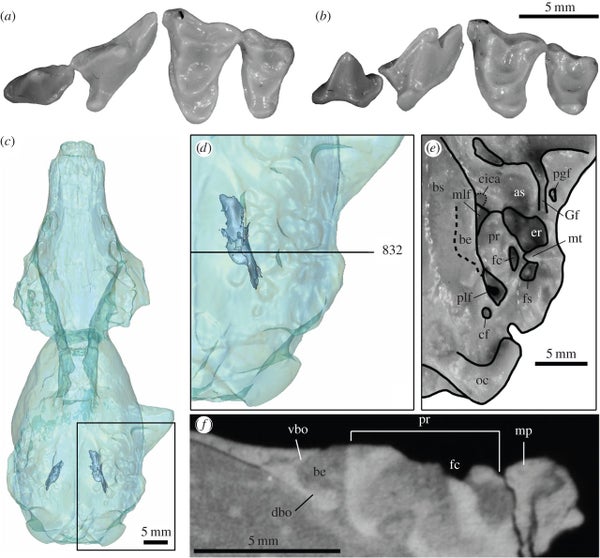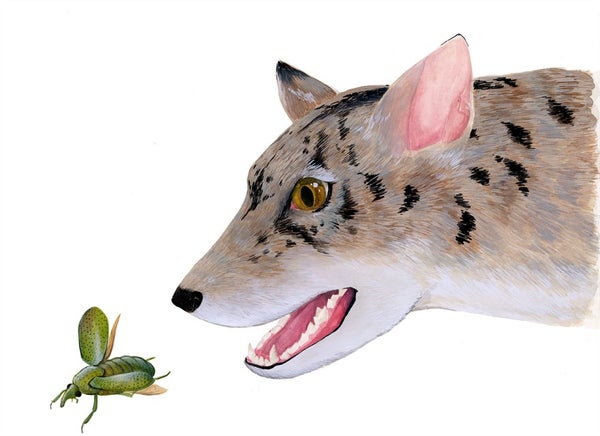This article was published in Scientific American’s former blog network and reflects the views of the author, not necessarily those of Scientific American
Every prehistoric species has its own route to discovery. Sometimes it's clear before the fossil is even out of the ground that it represents something new and unusual. Other times, it takes years of prep work and piecing bones together for the species' identity to be known. And then there are extinct creatures who go by one name only to be later recognized as something totally different. The third kind of story is what led paleontologists Susumu Tomiya and Zhijie Jack Tseng to name two of the smallest beardogs ever found.
Three decades ago, paleontologist P. Eric Gustafson described two new species of carnivorous mammals from skull and jaw pieces found in the 38-37 million year old rock of Texas. He thought they were both species of a previously-discovered animal called Miacis - a weasel-like mammal belonging to the archaic group from which carnivoran mammals, such as cats and dogs, sprung. But upon having another look at these fossils, Tomiya realized that they were something different. Together, Tomiya and Tseng determined that these "Miacis" were really very small beardogs, typically known as burly carnivorans that really do look like a cross between a bear and a dog.
The paleontologists have dubbed the newly-recognized beardogs Gustafsonia cognita and Angelarctocyon australis. They're among the earliest members of their lineage known and were about the size of a chihuahua, adding detail to a part of the beardog story between the group's origin and the later time, about 15 million years ago, when some of their ilk were larger than today's big cats. Exactly where beardogs first stepped onto the scene, however, is still unclear. Arguments can be made for Europe, Asia, and North America. Nevertheless, Tomiya and Tseng write, the new beardogs add to a growing picture that the southern parts of North America around 37 million years ago were places where mammalian evolution was taking off, spitting out many new forms that would spread elsewhere. With more fossils, paleontologists will eventually put together how these charming carnivores arose and eventually padded around the world.

The cranium and teeth of Gustafsonia. Credit: Tomiya and Tseng, 2016.
Fossil Facts
On supporting science journalism
If you're enjoying this article, consider supporting our award-winning journalism by subscribing. By purchasing a subscription you are helping to ensure the future of impactful stories about the discoveries and ideas shaping our world today.
Name: Gustafsonia cognita and Angelarctocyon australis
Meaning: Gustafsonia was named in honor of paleontologist P. Eric Gustafson and Angelarctocyon means "messenger beardog" for molar anatomy that presages what's seen in later members of the carnivorous group.
Age: Eocene, between 38 and 37 million years old.
Where in the world?: Trans-Pecos, Texas.
What sort of critter?: Beardogs, an extinct group of carnivorans related to, but distinct from, bears and dogs.
Size: About the size of a chihuahua.
How much of the creature’s body is known?: Gustafsonia is represented by a nearly-complete cranium, while Angelarctocyon is known from upper jaws and a piece of a lower jaw.
Reference:
Tomiya, S., Tseng, Z. 2016. Whence the beardogs? Reappraisal of the Middle to Late Eocene 'Miacis' from Texas, USA, and the origin of Amphicyonidae. Royal Society Open Science. doi: 10.1098/rsos.160518
Previous Paleo Profiles:
The Light-Footed Lizard The Maoming Cat Knight’s Egyptian Bat The La Luna Snake The Rio do Rasto Tooth Bob Weir's Otter Egypt's Canine Beast The Vastan Mine Tapir Pangu's Wing The Dawn Megamouth The Genga Lizard The Micro Lion The Mystery Titanosaur The Echo Hunter The Lo Hueco Titan The Three-Branched Cicada The Monster of Minden The Pig-Footed Bandicoot Hayden's Rattlesnake Demon The Evasive Ostrich Seer The Paradoxical Mega Shark
